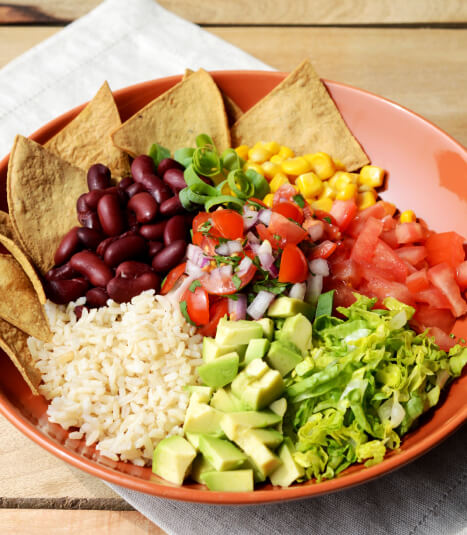The Ultimate Diabetic Diet Plan: How to Manage Blood Sugar Through Nutrition
Updated September 16, 2023

Currently, 37.3 million Americans have diabetes, and 96 million have prediabetes. Additionally, around 1.4 million Americans are diagnosed with diabetes each year, and it was the seventh leading cause of death in 2019.
And it’s going to get worse. It’s estimated that by 2030, 54.9 million Americans will have diabetes.
Due to how processed food is now, it’s easier to develop the disease. This is why you need to start treating your body better by changing your diet, whether you have diabetes or not. If you have diabetes, you need to follow a diabetic diet plan. You can also change to a plant-based diet to prevent diabetes if you’re concerned about developing diabetes in the future.
When left untreated, diabetes can increase the chances of developing kidney damage, nerve damage, blindness and even death. The National Institute of Diabetes and Digestive and Kidney Diseases (NIDDK) claims that diabetes doubles your risk of heart disease and stroke.
Nerve damage can be particularly harmful to a diabetic’s legs and feet. At worst, a person with diabetes can lose all sensation within them. This is called peripheral neuropathy, and it can cause a variety of problems because you won’t realize when you have injuries on your legs or feet.
Wounds and infections are more likely to happen with diabetes because the disease can cause your skin to dry out and crack. This can lead to infections and ulcers that never get treatment because you won’t feel them. Untreated wounds can eventually lead to amputation.
Diabetes is incredibly disabling for those who don’t control it. Learn how to take control of your (pre)diabetes through diet and get some tasty recipes to follow.
How Blood Sugar Levels Change Depending on What You Eat
When you eat, your blood sugar levels change whether you have diabetes or not. Someone without diabetes can produce insulin, which slowly brings down sugar levels to what they were before eating, and therefore have no problems.
People with diabetes, on the other hand, aren’t able to do this naturally. Type 1 diabetics have a pancreas that makes little to no insulin because their immune system attacks insulin cells. This is because Type 1 is considered an autoimmune disease, where the body recognizes part of itself as an enemy and attacks it.
Type 2 diabetics can produce insulin, but their bodies develop insulin resistance, meaning their bodies don’t respond to the insulin made. The pancreas tries to make more, but it overworks itself.
When someone has diabetes, food can drastically change their blood sugar levels, so they have to be careful about what they eat.
However, there are simple and complex carbohydrates. Simple carbohydrates have simple chemical structures. They’re used up quickly, leading to a faster rise in blood sugar levels.
Complex carbohydrates have a more complex chemical structure and contain healthy nutrients like vitamins, minerals and fiber. They take longer to digest and cause blood sugar levels to rise slower.
Why You Need a Diabetic Diet Plan
Controlling your blood sugar levels is tough, which is why you need a diabetic diet plan. As mentioned before, uncontrolled diabetes can lead to many health problems and a poor quality of life.
To manage your diabetes, you need to eat healthy meals regularly. Following a diabetic diet plan will help you manage your blood sugar levels easily without a lot of extra effort. A diet plan makes shopping and meal planning easier because everything will be laid out for you. All you need to do is pick and choose what you want to eat.
Following a plant-based diabetes prevention diet is even better. One study found that a whole-food, plant-based diet is good for preventing and treating type 2 diabetes. It also helps with other issues like cardiovascular disease, obesity, hypertension and inflammation.
Dr. McDougall’s Diabetic Friendly Diet Plan + Shopping List
To help you with your plant-based diabetic diet plan, Dr. McDougall has developed various prediabetes diet recipes for diabetics, created a 2-week meal plan and a grocery list to use.
Delicious Recipes to Help Prevent and Manage Diabetes
Another study agrees that a diet rich in high-quality plant food is connected to a significantly lower risk of developing type 2 diabetes. To jumpstart your new diabetic diet plan, here are some delicious diabetes-friendly Dr. McDougall recipes.
Remember that each person’s experience with diabetes is different, so the recipes listed below may work for some diabetics and not others. You may need to have different servings or replace one ingredient for another. Think of these recipes as a base to work from.
Breakfast
Here are a few different breakfast options:
- Baked Millet Breakfast Squares
- Baked Oatmeal with Apples and Raisins
- Banana Pancakes
- Breakfast Bowls
- Cinnamon Crunch Granola
- Fantastic Overnight Cereal
- French Toast
- Fruit and Oat Breakfast Bars
- Hot Cereal
- No-Huevos Rancheros
- Scrambled Tofu
- Tex-Mex Breakfast Tacos
- Veggie Benedicts
- Waffles
Lunch/Dinner
Here’s a variety of lunch and dinner options:
- Avocado and Tomato Pasta Salad
- Beefless Stew
- Bean Burritos
- Bean and Corn Enchiladas
- Bean and Corn Soup
- Beetroot Hummus Veggie Wraps
- Black Bean Chili
- Burrito Bowl
- Cathy’s Corn Chowder
- Caesar-y Salad
- Chunky Gazpacho
- Cream of Tomato Soup
- Creamy Beany Soup
- Crockpot Pizza Potatoes
- Cucumber Salad
- Hearty Minestrone Soup
- Herbed Avocado Toasties
- Hot-Cold Enchilada Salad
- Garbanzo Stew
- Grilled Portobello Burger
- Grilled Vegetables
- Layered Tex-Mex Lasagna
- Mac and Casheese
- McVeggie Burgers
- Mediterranean Greens
- Moroccan Chickpea and Cauliflower Stew
- Nutty Soft Tacos
- Pho Soup
- Quinoa Garden Salad
- Rainbow Rice
- Reuben Sandwiches
- Veggie Tacos
Snacks
Everyone needs a good snack to get through the day:
Diabetic Meal Plan for 2 Weeks
| Week 1 | Monday | Tuesday | Wednesday | Thursday | Friday | Saturday | Sunday |
| Breakfast | Waffles | Baked Millet Breakfast Squares | Scrambled Tofu | Fantastic Overnight Cereal | Veggie Benedicts | Breakfast Bowls | French Toast |
| Lunch | Bean and Corn Soup | Mediterranean Greens | Beefless Stew | Layered Tex-Mex Lasagna | Cucumber Salad | Avocado and Tomato Pasta Salad | Rainbow Rice |
| Dinner | McVeggie Burgers | Chunky Gazpacho | Bean and Corn Enchiladas | Reuben Sandwiches | Crockpot Pizza Potatoes | Burrito Bowl | Beetroot Hummus Veggie Wraps |
| Snack | Banana Blueberry Bars | Chubby Chips | Cornbread | Baked Yams | Tortilla Chips | Squash Fries | Banana Blueberry Bars |
| Week 2 | Monday | Tuesday | Wednesday | Thursday | Friday | Saturday | Sunday |
| Breakfast | Banana Pancakes | Hot Cereal | No-Huevos Rancheros | Breakfast Bowls | Baked Oatmeal with Apples and Raisins | Scrambled Tofu | Veggie Benedicts |
| Lunch | Grilled Vegetables | Black Bean Chili | Hearty Minestrone Soup | Herbed Avocado Toasties | Cream of Tomato Soup | Nutty Soft Tacos | Hot-Cold Enchilada Salad |
| Dinner | Mac and Casheese | Veggie Tacos | Caesar-y Salad | Cathy’s Corn Chowder | Grilled Portobello Burger | Moroccan Chickpea and Cauliflower Stew | Bean Burritos |
| Snack | Chubby Chips | Banana Blueberry Bars | Baked Yams | Squash Fries | Tortilla Chips | Cornbread | Squash Fries |
Diabetic-Friendly Shopping List
Here’s a shopping list to help make trips to the grocery store easier. Of course, feel free to use this as a base and then customize it to your meal plan.
Fruits
Here are some diabetic-friendly fruits:
- Apples
- Apricots
- Avocado
- Banana
- Blackberries
- Blueberries
- Cantaloupe
- Cherries
- Dates
- Grapes
- Grapefruit
- Oranges
- Peaches
- Pears
- Plums
- Strawberries
Veggies
We’re including both starchy and non-starchy vegetables in this section:
- Artichokes
- Arugula
- Asparagus
- Beets
- Bell peppers
- Broccoli
- Brussels sprouts
- Cabbage
- Carrots
- Cauliflower
- Celery
- Corn
- Cucumber
- Eggplant
- Garlic
- Green beans
- Kale
- Onions
- Potatoes
- Pumpkin
- Romaine lettuce
- Squash
- Sweet potatoes
- Tomatoes
- Yams
- Zucchini
Whole Grains
One study found eating whole grains lowers the risk of type 2 diabetes, so don’t forget to pick up some:
- Barley
- Brown rice
- Cornmeal
- Millet
- Oatmeal
- Popcorn
- Quinoa
- Whole-grain bread
- Whole-grain flour
- Whole-wheat pasta
Legumes
Legumes are how you’re going to get most of your protein, they include:
- Black beans
- Fava beans
- Garbanzo beans
- Kidney beans
- Lentils
- Pinto beans
- Soybean
- White beans
Nuts/Seeds
Nuts and seeds offer a variety of nutrients and also make for a great snack. But you should limit these as they are very high in fat and are calorie-dense:
- Almonds
- Cashews
- Chia seeds
- Flax seeds
- Peanuts
- Pecans
- Sesame seeds
- Sunflower seeds
- Walnuts
Success Story: Denver
Denver is just one of many McDougall Program diabetes success stories. Denver suffered from joint pain, body aches and inflammation. She was also told that she was prediabetic.
So, she decided to make some major changes in her life, starting with what she ate. While looking for a diabetes-prevention diet, Denver found and joined The McDougall Program. After three or four days of eating the McDougall diet, she started feeling better and “felt that her body was saying it’s about time.”
After six months of following the program, Denver’s doctor told her she was no longer pre-diabetic.
Take Control of Your (Pre)Diabetes Through Your Diet
Getting diagnosed with (Pre)diabetes can be an opportunity to improve your life. By following a plant-based diabetic diet plan, you can manage your blood sugar levels and feel amazing at the same time. And, if you’re looking for a diet to prevent diabetes, plant-based diets have been proven to help.
If you’re worried about trying this new diet on your own, join The McDougall Program. The 12-day program is 100% online and will educate you about nutrition from Dr. McDougall himself. You’ll also get a year of support from your dedicated Support Specialist.
Join the program today and take control of your health and your life.
Recommended Articles

What is the Best Formulation of Vitamin B12?

The 10 Most Healthful Packaged Foods






